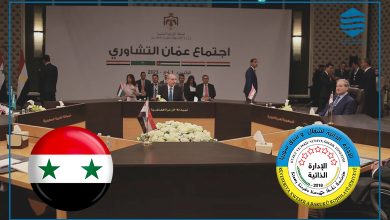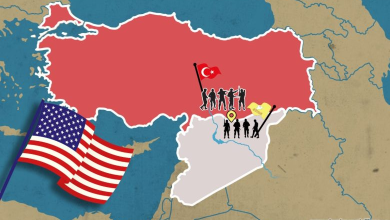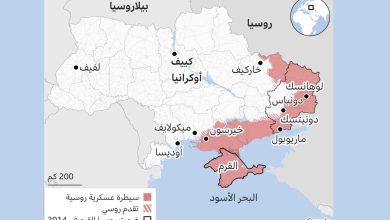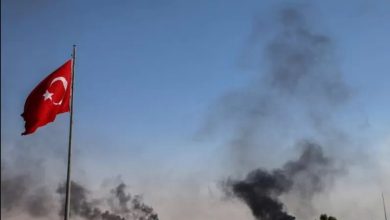
The Kurdish Spirit Shines inside Iran’s Feminist and Youth Revolution
Al- Furat Center for Studies- Translation Department
The killing of the Kurdish Iranian girl Jina (Mahsa) Amini did not pass through like any other event in the course of the previous Iranian popular protests against the Islamic Republic’s regime. Although Iran’s Islamic regime had committed brutal crackdowns against dozens of women, who were on the list for killing and arbitrary detention, the killing of this young girl and being tortured by the “Morality Police”, aroused complex emotions for the whole Iranian people, who rose up against this theocratic dictatorship that controls its daily life’s details, for instance, women’s lack of freedom to dress.
In the eyes of the Iranian people, and even in the eyes of the civilized world, the reason for Jina Amini’s loss of her life is considered a reason that can only be invoked by dark forces and the most radical Islamic organizations, such as ISIS, Al-Qaeda and the Taliban.
The 22 years old girl, who was visiting her relatives soon has tragically been killed in the blink of eye, it has stirred up in the Iranians’ minds the notion of injustice, which occupies a significant room inside the Iranians’ collective memory and has been repeated in the daily life of the Iranian citizen on a daily basis after this notion had been drifted off the track of religious ideology. The Islamic regime in Iran constantly promotes this notion, in order to consolidate itself inside Iran and to expand into the region, too. Its transformation to the injustice of an ancient people with its different components against the medieval theocratic regime, which seeks to divert its civilization and culture throughout giving priority to the sectarian and religious nature.
These reasons pushed the Iranian to take to the streets and go out in massive demonstrations that spread all over Iran; it is still expanding to this very moment. These demonstrations held the features of a new phase in Iran’s modern history and have become a turning point in the process of the Iranian people’s consciousness and perhaps the Eastern, due to handling one of its most complicated issues i.e. Women.
The veil (Hecab) from historical and social heritage to a symbol of the Islamic regime
The veil was common among women in Iranian society before the victory of “the Islamic” revolution in 1979. The veil and chador (a full body cloak) have become the symbol of the rebelled women from different political and intellectual tendencies against the Shah’s regime, due to their empathy with the Islamic trend that was developed within the revolution and was being exposed to a severe crackdown, and did not have radical ideas at the time. Especially, since its slogans were calling for reformation and democracy, and the authoritarian and totalitarian notion of Wilayat al-Faqih had not been introduced yet, and there was a state of societal satisfaction towards the Shiite religious authority, which was standing by the people of Iran against the despotism of the successive monarch governments throughout history. Moreover, the people’s deep resentment from the Shah’s oppressive policies, and imposing a law that states removing the Hecab, and preventing veiled women from entering formal institutions.
Some Iranian researchers see wearing black veils dates back to Iranian mythology, before Islam, and getting dressed in black and mourning the Persian Prince “Siyush”, who was unjustly killed outside the country by order of “Afrasyab” after being accused of treason, according to the holy book of Zoroastrianism (Avesta) and “Shahnama” book by Ferdowsi. This story will come into Iran later in the form of the character of Hussein s personality, after the entry of Islam into Iran The Iranians have maintained the rituals of mourning that have continued to this very day, The black veil, after the Safavids converted the doctrine from Sunni to Shia, became a symbol of grief over the 12 Shia imams, and this belief still exists today in Iran’s present regime.
In the aftermath of the “Islamic” revolution’s victory, Khomeini issued statements against unveiled women and accused them of not taking part in the revolution against Shah. Another resolution was issued following that, which stated imposing compulsory Hecab on women. However, the day after this resolution had come out, which marked 8 March, World’s women Day, thousands of women took part in demonstrations against imposing wearing Hecab. This led the religious leaders to retreat temporarily from the resolution, then the Islamic regime adopted a gradual plan to impose Hecab once again; in the beginning, the Hecab was imposed on government’s employees, preventing unveiled women from entering governmental institutions, imposing Hecab on girl students, and then on all women who aged 9 years old, whether Muslims or from another religion, until it has become a formal law that is penalized by law. The penalty of not wearing Hecab amount to whipping and two months of imprisonment. But, the Iranian judiciary circumvents this penalty; it can transform it into the penalty of spreading obscene publicly, which could amount to 10 years of imprisonment, or to abusive practices against women, and a good example in this regard, is the killing of Jina Amini, who had been arrested and lost her life after was being tortured because of “improper” wearing of Hecab.
the goal behind the policy of the Islamic Republic of imposing the veil on women is perhaps to turn it into a symbol for it, to create an Islamic lifestyle and an anti-Western society lifestyle, and to consider every violation of this as an opposition to this regime, and classifying it within the category of conspiracy in favor of the West.
However, it cannot be denied that a segment of the Iranian society maintained women’s Hecab as the case in the rest of the Islamic societies in the Middle East.
Over time, the expansion of the gap between the state and people, escalation of the crackdown on freedoms, deterioration of the economic and livelihood conditions, regime’s lack of minimum attention to the people’s demands of a dignified life, their access to the simplest requirements of their daily life, turning them to a pawn to its religious and political ideology and the export of the Islamic revolution, the state of ignorance and superstition that is being spread inside the society by the religious leaders, and the oppression that is being practiced against women. Most importantly, the rise of a new generation, who is open to the world, is not subjected to this theocracy, and is aware of the scale of tragedies that the later regime caused them and the peoples of the region; all these reasons pushed the Iranian women to start the revolution against this patriarchal theocracy that it considers women his weak point, practices most severe crackdowns against her. Iran has witnessed several women protests against the veil also known as Hecab in the last few decades; most notably a series of protests that the Iranian young girl “Fida Mouahhad” had sparked, when she stood on the street and sat on a box and put her Hecab on a stick and waved to those who passed. She had been arrested the next day, and they called those protests “the girls of the revolution’s street”. Recently, video footage of Iranian girls in some Iranian cities; Shiraz city, for instance, has been released, in which they challenge the regime and stroll bareheaded in one of the city’s public squares. Reportedly, all women who had taken part in that gathering have been arrested.
The Features of the Current Iranian protests and its difference from the previous ones
Perhaps what distinguishes these demonstrations that spread all over Iran today, is the difference in the form of its spark; in the previous demonstrations the spark was either related to political reasons, as it happened in the Green Movement’s protests that broke out in 2009, and it was led by the reformists, due to the fraud processes that occurred in the presidential elections at the time, which resulted in the inauguration of the fundamentalist hard-liner president, Ahmadinejad, or for economic reasons as it happened in the “Gasoline uprising” in 2019, which broke out because of a hike in the oil prices by the Iranian Government up to 300%, or for reasons related to the livelihood, public services and a dire life circumstances; such as the labor syndicates and retired teachers protests, and the protests that broke out after the “Metropol” commercial building had collapsed and dozens of people had lost their life. They pointed fingers at the municipality for the collapse of the building, and they held the responsibility for the accident to the government.
Whereas the current protests have a direct reason that differs from the previous protests in the past, the killing of a young Kurdish-Iranian girl was a shock to the Iranian people that have never felt such a thing before. It is perhaps similar, to some extent, to the shock of the victims of the Ukrainian plane accident, which had been shot down by the Iranian Revolutionary Guards Corps (IRGC)’s missile, after the killing of Qasim Suleimani, or to the killing of “Nada Agha Sultan” the Iranian girl, who had been killed by a sniper during the” Green Movement” protests. However, the context of events is different this time; both of these two cases happened in a turmoil context at the time, whereas, this girl, who has been turned into a symbol for one of the prominent feminist revolutions all over the world, was in the natural context and she was unjustifiably beaten under any pretext.
This incident has provoked complex feelings for the Iranian people, especially, women; the strange girl who faced the tragic fate, who had come to visit the capital, touched upon the Iranian imagination that is deeply rooted in history. It also has incited the victimhood feelings that imbued with their collective memory; beginning from Siyush to Hussein, who have been killed in a state of injustice and at a foreign place, all the way to all the victims who have been killed by the Iranian regime for more than four decades.
The other thing that increased the enthusiasm of the Iranian youth and pushed them to engage eagerly in these demonstrations is the heroic stance of Jina’s family and her father’s refusal in obeying the authorities’ orders to bury his daughter at night time, in order to avoid demonstrations that might spread to other areas in Iran- that is exactly what happened- in addition to his refusal of all pressures that the Iranian authorities still practice on him to give false testimony about his daughter’s past suffering from brain damage.
There are differences that form the feature of these demonstrations that can be summarized as the following:
1- It surpassed the shapes and frameworks of the previous revolutions and outlined a modern patriotic identity for the Iranian people with its various components in the future. This is evident from the slogans shouted during the demonstrations, which focus on solidarity amongst different Iranian nationalities.
2- The emergence of Iranian women’s persona and her clear role more than the previous demonstrations, the removal of the well-known stereotyped image of veiled and submissive Iranian women, showing how modern the new generation of both Iranian women and youth are, and their vitality and eagerness for freedom and change.
3- Highlighting Kurds in Iran, who have suffered a double crackdown since Shah’s regime and the current regime alike, perceiving them as the main driver of these demonstrations, a girl from a remote Kurdish area turned into an icon of these demonstrations, which might turn to a massive revolution that will be written in history.
4- Bypassing the Iranian opposition with all its forms and showing a state of a developed awareness of the public, a good example in this regard, is the participation of Azeri, Arabic, Persian areas, and other components after they found out that the Reformists rode the wave of demonstrations and attempted to contain it for their favor, and the regime’s attempts to show that the Kurdish areas seek for separation in these demonstrations.
5- Bypassing gender identity and masculine hegemony around the world for more than five millennia. This is probably evident in the demonstrations’ spark under the banner of its core issue “woman”, in addition to the unique solidarity shown by the Iranian youth when they cut their hair just as women did mourn the killing of that young girl (Jina) in a funeral ritual rooted in Iranian and Mesopotamia myths. However, this Scenery has deep connotations and is unprecedented, unlike the Arab Spring’s revolutions, and even any other protest movement in the world.
6- Chanting new and different slogans that express a new phase, in which the Iranian people were able to crystalize them throughout a series of previous protests and outlining the next phase, which the young Iranian generation aspires to. Here are the most prominent slogans as the following:
a- Women, Life, Freedom: is a slogan that had been chanted in the Kurdish language, in the first place, in the Kurdistan region of Iran, soon later, the protesters translated it to Persian in other cities of Iran including Tehran, to become a slogan of the Feminist revolution of Iran. This slogan goes back to the Kurdish female fighters also known as Women Protection Units (YPJ) in Rojava, during their fight against ISIS terrorists, which is considered one of the most notorious terrorist and anti-women organizations. This slogan is inspired by the feminist philosophy of the Kurdish leader and thinker, Abd-Allah Ocalan, who is considered inspiring for them. this slogan bypassed Iran’s border, to be chanted in different parts of the world, it made headlines in major international journals, such as the French “ Liberation” journal, in which the French philosopher, Jean-pall Sartre was a founding member.
b- Mojtaba Khamenei, you will die, you will not be a Supreme leader: this slogan manifests the decision that the Iranian people made and their refusal of the regime of Wilayat al-Faqih, and the plan that is being done to inaugurate Mojtaba Khamenei as the next supreme leader for the country after passing of his father, Ali Khamenei.
c- Kurdistan is the light of Iran’s eyes, and the whole of Iran is covered with blood; from Kurdistan to Iran”, such slogans express a tendency that gets over any ethnic and geographic obstacles compared to the strengthening sense of the belonging to the motherland, Iran, and lifting the injustice state on the Kurdish areas, which was renewed by the killing of this Kurdish girl, especially these areas have suffered a great deal of oppression and despotism of the successive ruling regimes over Iran.
d- Be wary of the day we hold weapons
This slogan reflects a significant shift in protesters’ insistence to topple the regime, even if their movement shifted to a militarized one, and this tendency was not pushed for during the previous popular demonstrations.
7- Some areas and neighborhoods have become out of the control of the security forces, most notably, based on reports from inside Iran, the Kurdish protesters took control almost completely of the Shino city of the Kurdistan province, and this indicates the intensity of the popular movement in the Kurdish areas, the same thing could happen in the other areas of Iran, this is what was reflected in AzizollahMaleki’s statement, the police chief in the northern Gilan province of Iran, for the “Gilan News” website saying: “Since few days we are about to be defeated”, but, soon later, this statement had been deleted from its website.
8- Widening the span of demonstrations against the Islamic Republic’s regime into all Iranian provinces (31) according to Iranian activists and political analysts. Therefore, these demonstrations are wider than the violent October protests in 2019, which erupted in 28 provinces at the time and resulted in the killing of 1500 people.
International Reactions
International reactions have followed the killing of Jina Amini and the crackdown that is being practiced by the Iranian authorities against women, including the American president, Joe Biden in the United Nations, who declared standing by the Iranian women and supported their right to demonstration. The International Amnesty Organization called for a criminal investigation into the Killing of this young girl and the officials and the perpetrators should be held accountable and brought to justice. The US National Security Advisor, Jake Sullivan, confirmed that they would keep putting pressure on Iran so that it would stop its human rights violations.
Aside from the heads of states and human rights organizations’ statements, there had practically been a marked shift in dealing with the widespread protests movement in Iran; with regard to cyber warfare and getting access to the internet, which is considered the rebelled peoples’ weapon, to be informed about the latest developments on the ground in all over Iran’s Geography, to coordinate amongst each other, whether inside a city or amongst all cities and also to disseminate the regime’s crackdown practices, which would contribute to disclose these practices, and this might lead to transformations in the rest countries of the world throughout the formation of public pressure on its governments. On the other hand, the Internet is considered a State’s weapon, the Iranian regime used to cut the internet whenever there is huge demonstrations taking place against him, in order to disrupt the coordination amongst demonstrators, to take control easily, and to prevent the events on the ground from going public in all over the world.
The United States Department of Treasury has announced the issue of the Iranian General License D-2, to increase the support for internet freedom in Iran, “technology firms will be able to provide more digital services to people of Iran, from access to cloud computing services to better tools and the use of Virtual privet Network (VPN) to enhance their online security and privacy”. It stated.
This resolution came after the quest of Ilon Mask, the Executive Director of the “X space” company for the US Department of Treasury to exempt Iran from sanctions, to provide Iran with “Starlink” internet service throughout Satellite service. This quick response in accepting this quest and lifting partial sanctions on Iran, which usually needs a profound study and it takes a lot of time and many administrative procedures, reflects a significant shift in the US eagerness for this movement. This reminds us of the same service that had reached Ukraine at the previous time of this year, due to concerns about the cutting of the internet in light of the Russian invasion of Ukraine.
There was another solidarity that has a great impact on the popular movement in Iran, which was seen after the biggest global group of hackers, which has anarchist tendencies and is known as “anonymous” i.e. unknown, announced its support for the popular movement in Iran and threatened the Iranian regime that it would cut the internet on many sensitive governmental websites and institutions, for instance, hacking Islamic Consultative Assembly(Parliament), the Iranian Republic Presidential’s website, and the State’s run Television; disrupting the Central Bank’s website and closing Khamenei’s website; they also hacked Legal Medicine Research Center and got on its database, in addition, to disrupting and hacking hundreds of monitoring cameras in the Iranian streets, which had been set up to monitor the protests and get to know the demonstrators.
This group said in its recent statement that was directed to the Iranian regime leaders,” you will not get benefit from money stained with blood”, this was after they hacked both websites of the Oil and Economy of Iranian Ministries.
Scenarios of the next coming days in Iran
This group said in its recent statement that was directed to the Iranian regime leaders,” you will not get benefit from money stained with blood”, this was after they hacked both websites of the Oil and Economy of Iranian Ministries.
The Iranian regime is an introverted regime more than any other despotic regime in the region, these regimes do not accept any reform process in their structure and do not subject to popular demands, all the previous demonstrations have proven such notions, which have ended with a brutal crackdown, but their resentment feelings remained the same despite being putting an end to these demonstrations temporarily, and they wait for another break out whenever they have a chance.
Since the regime enjoys a long experience and is ready to crack down on any anti-Islamic Republic regime movement. The use of violence and suppression in this popular movement is expected, however, in light of these indicators, this would require the regime to go harder in cracking down, which could end up in unforeseen destiny because this is related to the course of the events and its development, especially if it moved towards armament.
According to available information from some political activists circulating on the ground, the Iranian regime would resort to its proxy groups to crackdown these widespread protests, and some of them are already taken part, such as “Liwa Fatemiyoun” which is composed of Afghani citizens, amid reports of moving some factions of Iraqi “people’s Mobilization Forces” (PMF) to the capital of Tehran.
Therefore, we might be before several possibilities in the next coming days that Iran would witness, which are as the following:
- The Iranian regime could resort to a harsh crackdown in its attempt to suppress demonstrations as soon as possible as it did in 2019, which it was able to put an end the protests with three days, in order to avoid chaos and to be in control of the situation, especially with the opening of schools and universities, to prevent the extension of abstaining of going to work to the other institution, subsequently, moving towards a state of a strike, if these demonstrations have continued. However, this time the bloodshed bill would be too expensive, and the rift between the regime and the people would be widened, who have decided to change this ruling regime. Therefore, another break out of any movement would be even harder and deeper, and this can be concluded from the track of successive protest movements and their changes during these last few years, which increases the possibility of the collapse of the regime in the future.
- The regime’s focus on Tehran; the crackdown could be harder than the rest of the region, which would give it a chance to organize itself more, especially in the Kurdish areas, which are considered the hub of the ongoing revolution and have a long history in the struggle. Plus, they have bigger political and organizational capabilities than the rest components of Iran, and one of these indicators is the partial control of the city of Shino by the demonstrators before the rest of the Iranian other cities.
- The continuation of demonstrations and it is getting harder, joining other sections of the people, alongside a state of civil disobedience and general strikes inside the state’s institutions, universities, oil companies, and labor syndicates, which have always declared on strikes due to difficult living situations, low salaries, failure to pay in time, during last few years. Thus, this movement could gradually take the shape of the 1979 revolution that toppled the Shah’s regime, there is no doubt this would be accompanied by a state of harsh violence, which might lead to militarize the revolution that we could witness defections amongst the ranks of the regular Army that the majority of the people count on it and demand it to join them.
- If the course of events went according to the third scenario and the revolutionaries and people got the real support of the international community, the US in particular, this is a possible thesis, especially, if the death of the nuclear deal with Iran has been declared, and the US believed that there is no way to change the behavior of the Iranian regime and pulling it out from the Russian- Chinese axis towards the western axis, the balance would probably be tilt in revolutionaries favor. We cannot forget the role that Israel could play in this turmoil, since it used to take advantage of any gap or disruption within the regime’s structure. If we go back a few days and months ago to look into the news of Mossad’s penetration within the IRGC’S intelligence at a time when the regime was at its peak of power. It would be possible to expect a move on a large scale and easy to contribute more in the toppling of the regime in the light of losing control over the country. Subsequently, we might witness the end of the most notorious, despotic regimes and radicalized regimes in the region and the world, and we would have a new era ahead, this would also contribute to resolving other crises knots in the region’s country, in which the Iranian regime was the direct cause behind them if these states witness similar revolutions against Iran’s proxy groups that control the decisions of these states.





